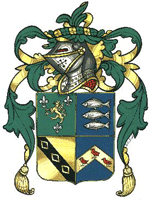                  
I
|
|
St. Issey Parish, North West Cornwall
To carry out any research on our family in England became very difficult so initially the services of a genealogist in that country was obtained and later the services of two historians. Their research along with my personal visits in July 1990 and July 1993 and a lot of information supplied by members of the greater Trevethan family world wide make up this interesting history and insight into lives of the Trevethan's in Cornwall both today and in the years long since gone by.
Working on the information that I was able to provide, the genealogist made his first search for our family in the 1851 census returns of Wadebridge, which is in the parishes of St. Breock and Egloshayle, Cornwall. The first census whose returns were of any use to the genealogist was taken in 1841. The entries gave the name of all members of a household, their relationship to the head, occupations, ages to the nearest multiple of five below their actual age (except children under 15, whose true age is given) and the answer ‘Yes’ or ‘No’ to the questions ‘Were you born in the county in which you are now living?’ The later censuses available for public inspection - 1851, 1861 and 1871 in England and Wales, but as late as 1901 in Scotland - gave ages and birthplaces more precisely.
Although they covered the whole of the returns for the two parishes, which had a combined population of 2785, they found only one family of our name and this they were unable to link with our forbears.
Address: Wadebridge, St. Breock, Cornwall
Ann Trevethan Head Widow 32 Charwoman
William Son 7 Scholar
Charles Son 6 Scholar
George Son 5 Scholar
John Son 3
Susan Daughter 1mth
The children were all born in St. Breock Parish while the mother was born at Eglos Hayle.
They decided next that they must try, by obtaining the birth certificate of one of David and Elizabeth Trevethan’s children to get a more accurate address at which they might trace our family in the census returns, this being the only way of establishing David’s birthplace. David and Elizabeth are of course the parents of the brothers and sister who eventually came to New Zealand. In seeking a birth certificate the public has access only to the enormous quarterly volumes of indexes at the General Register Office. These give simply the name of the child the registration district within which the birth took place and a reference to the full certificate. Short of buying all the certificates of a particular name to be sure of obtaining the relevant one, it is necessary to have other details checked. After only two checks they obtained the certificate of Thomas Trevathan.
Thomas Trevethan who was the first Trevethan to come to New Zealand was born on the 28th of May 1850 at Trevance (see photo to left) a small hamlet near St. Issey, Cornwall.
St Issey, is in the hundred and Deanery of Pydar, is situated about 2.5 miles south of Padstow and about 5 miles north of St Columb. The principal hamlets of the parish, apart from Churchtown, are Tredinnick, Trenance and Trevance. The manor of Canalissey or Cannalidgee belonged for many years to the family of Coleshill. Halwyn, now called Old Town was formerly a manor on which was the magnificent seat of the Champernowns. The site of the barton, where are still to be seen (1814) ruins of the manor house and of a chapel, passed to three gentlernen who also possessed the manor of Tregenna which once belonged to the Arundells. There was also a manor at Trevorrick and an extensive manor of St Ide stretching into neighbouring parishes. Blable, now a farm, is probably the Blaybol which much earlier was the seat of a branch of the Arundells.
Thomas was the son of David Trevethan a labourer, by his wife Elizabeth, whose name before marriage was Saundry. His mother registered the birth on the 10th of June 1850, signing the register by mark.
St. Issey is in fact a parish just to the west of St. Breock so our information was not greatly in error and this time their census search was successful.
Address: St. Issey, Cornwall. Hamlet of New Barn.
David Trevethan Head Married 25 AgricLab
Elizabeth Wife Married 23
Jane Daughter 3 Scholar
Thomas Son 10 mths
David and his children were born at St. Issey while his wife was born at Lanivet. This is the family of which five of the children were later to come to New Zealand.
Address: New Barn, St. Issey, Cornwall
Thomas Trevethan Head Married 60 Agric Lab
Alice Wife Married 62
John Son 20 Agric Lab
Zacheus Son 16 Shoe maker
Thomas and his children were born at St. Issey while his wife was born at St. Mawgen.
Address: Village of Burgois
Thomas Trevethan Head Married 22 AgricLab
Nancy Wife Married 25
Mary Daughter 1
Samuel Trevethan Head Married 26 Agric Lab
Mary Wife Married 29
Isaac Son 3
All the above people were born at St. Issey.
As you can see, in addition to the family of David and Elizabeth they also found three others of the name living in the parish and thought the elderly Thomas might well have been the father of David, Thomas and Samuel. The way to discover whether this was so, at least for David, was to obtain a copy of his marriage certificate, searching back in the indexes from 1850.
David Trevethan married Elizabeth Saundry on the 6th of June 1846 at the parish church of St. Issey, Cornwall. David stated that he was a bachelor and a labourer, the son of Thomas Trevethan, a labourer. Elizabeth was a spinster, the daughter of Peter Saundry, a labourer. This put to rest the New Zealand theory that Elizabeth Saundry was from gentry and married below her station in life. Both bride and groom were not of full age, and were living at Trevance and the wedding ceremony was witnessed by William Hugo and Thomas Stone.
You will have noticed that since writing about our family in Cornwall I have changed the spelling of our name from Trevathan to Trevethan as that is the way it is spelt in Cornwall. It appears that the spelling changed upon their arrival in New Zealand and is indeed spelt both as Trevethan and Trevathan in Australia and the United States of America. While on spelling, you will notice that in a number of places that the spelling alters as when a person was illiterate, the spelling of their name was not consistent on their birth and death certificate.
The search then moved forward to the 1861 census returns for the entire parish of St. Issey (population 720) to see if our family was still in the district.
Address: Trevance, St. Issey, Cornwall.
Zaccheus Trevethan Head Married 27 Shoemaker
Susan Wife Married 29
Thomas Lodger Widower 67 Ag. Lab.
Zaccheus and Thomas were both born at St. Issey while Susan was born at St. Eevan.
Address: Trevance Merewick, St. Issey.
Samuel Trevathan Head Married 38 Ag. Lab.
Mary J Wife Married 26
Isaac Son 13 Ag. Lab.
Eliza Dau 9
Mary Dau 5
Jane Dau 2
Robert Son 1
All of this family were born at St. Issey except Mary who was born at St. Colomb.
Address: Lower Tredore, St. Issey, Cornwall.
John Trevathan Head Married 30 Ag. Lab.
Jane Wife Married 24
Richard J. Son 5 Scholar
Mary E. Dau 3
Evan T. Son 2 mth.
Jane was born at Roche and Mary at Padstow while the rest of the family were born at St. Issey.
Address: Village of Treddinick, St. Issey.
Thomas Trevathan Head Married 33 Farmer
Nancy Wife Married 35 Far.Wif
Mary Dau 11 Scholar
Thomas Son 9 Scholar
James Son 7 Scholar
William Son 5 Scholar
Henry Son 4 Scholar
Elisha Dau 2
Hester Ann Dau 9mth.
It is interesting to note that Thomas and his wife were farmers of four acres. The complete family were born in St. Issey.
All of these families belong on our family tree and can be seen on the tree buttons below. However unhappily our direct ancestor David, the brother of John and Zaccheus mentioned above was not at St. Issey when the census was taken, and in order to discover where he might have been a copy of the birth certificate of a child born near 1861 was obtained.
Maria Trevethan was born on 12th January 1864 at Tregunna, St. Breock, Cornwall. She was the daughter of David Trevethan, a farmer, and his wife Elizabeth Trevethan, formerly Saundry. Her father registered her birth on 23rd January 1864, signing the register by mark. Maria was later to immigrate to Australia and marry John Betts. They later moved on to New Zealand and came to Central Otago.
St. Breock is in fact a neighboring parish of St. Issey, lying immediately to the east and the hamlet of Tregunna is only five miles from St Issey. A search of its 1861 census returns revealed the entry for the family we sought.
Address: Tregunna, St. Breock, Cornwall.
David Trevethan Head Married 35 Farmer
Elizabeth Wife Married 33
Thomas Son 10 Scholar
M.A. Dau 9 Scholar
Wm. Son 5 Scholar
Emm Dau 3
David Son 1
The birth places of this family were only given as Cornwall and David was listed as a farmer of 18 acres. Their family had now grown to five children and includes three of the five who later emigrated to New Zealand.
To be sure of tracing all the children of David and Elizabeth Trevethan a search of the transcript of the St. Issey registers at the Cornwall Record Office in Truro was made.
St. Issey, Cornwall. Bishop’s Transcripts - Baptisms 1863 back to 1845.
16 May 1847 Jane Trevethan daughter of David and Elizabeth of Trevance, labourer.
It is clear that as this was the only entry that after the baptism of their eldest child, David and Elizabeth stopped attending the St. Issey church, having moved away - perhaps to St. Breock. Their son Thomas may have been born in his grandparents’ house at St. Issey in 1850, and baptized elsewhere. On the other hand the family may have become even temporarily Nonconformist for there were Independent and Wesleyan Methodist chapels in the parish.
However the excursion into the St. Issey registers was not wasted, since they traced the baptisms of David Trevethan senior and his brothers and sisters.
St. Issey, Cornwall. Bishops Transcripts - Baptisms 1810 to 1844.
11 March 1821 William son of Thomas and Alice Trevethan of Penlison, St. Issey.
10 August 1823 Samuel son of Thomas and Alice Trevethan of Trevance.
19 March 1826 David son of Thomas and Alice Trevethan of Trevance.
26 October 1828 Thomas son of Thomas and Alice Trevethan of St. Issey, labourer.
6 January 1831 John son of Thomas and Alice Trevethan of Trevance, labourer.
26 November 1833 Zechariah son of Thomas and Alice Trevethan of Trevance, labourer.
Furthermore, the marriage registers provided the entry for Thomas and Alice the grandparents of the family which came to New Zealand.
St. Issey, Cornwall. Bishops Transcripts - Marriages 1818 to 1821.
29 July 1820 Thomas Trevethan of the parish, labourer and Alice Hicks of this parish, spinster. Witnesses: Thomas Colman, Cales Hawkey, John Badd.
Life In Cornwall in the 1800’s.
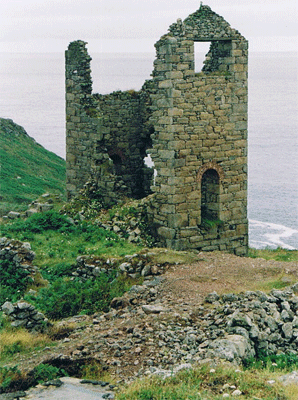 |
| Mine at Lands End, Cornwall |
The question that remains to be answered is why did the five young people from Cornwall set out on a dangerous sea journey to the other side of the world? To understand the possible reasons one needs to look at the conditions prevailing in Cornwall at that time.
The lives of the Trevethan or Trevathan family, as evidenced by the Census Returns of 1851 and 1861 and the Parish Registers, revolved around two of Cornwall’s traditional primary industries, farming and mining, and one of its subsidiary industries, slate quarrying. The farming activities of the Trevethans seem mainly to have focused on Trevance, Lower Tredore, New Barn and Benuick. The lane leading to Benuick, where lived Samuel and Mary Trevethan and their six children in 1861, was a “sanding lane”, used by farmers to load sand from the edge of the estuary of Benuick creek into carts for spreading on the land as fertilizer. The mining was probably carried out at Carthew mine near Trevear Farm. Carthew Farm, at the head of Pinkson Creek, is the site of the old Phoenix mine, whose name changed to Carthew Consols in 1847. It went out of production in 1853, but reopened in the early 1860s before finally being abandoned in 1867. Copper was mined here, and the ore was loaded down to the quay for shipment to Padstow and thence to Bristol. On the opposite side of the creek, Penhale mine extracted silver-lead ore. The slate mining was carried out around the hamlets of Tregunna and Edmonton. This latter hamlet was built by Edmund Hambly (Died 1869), who owned the Penquean Slate Quarry near Tregunna, for the men who worked there.
Padstow harbour has been a very important one, being one of four on the west coast that provides shelter for the larger coastal vessels from westerly gales. Padstow boasted at least six shipbuilding yards in the 19th. century, and exported copper ore to Bristol, as well as slate from Camel Quarry, antimony and lead ores, and also cheese, wheat, barley, oats, and cured fish including pilchards. Imports included coal from South Wales to fuel the steam-powered Industrial Revolution in the mines; timber from Norway and Sweden; woolen goods, glass, salted hogs, and tallow from Ireland; salt, wine and vinegar from France; linen and canvas from Brittany; malt and hardware from Severn Estuary ports; and hemp, iron and jute from Russia.
The entrance to Padstow harbour is guarded by an under water bank of sand which only has a narrow entrance close in to Stepper Point. Many houses were lost in the sixteenth century when this bar first appeared after a severe storm, but legend has it that this was as a result of a Padstow fisherman who shot a mermaid with an arrow, thinking she was a fish. In her dying breath she placed a curse on the town and threw sand at the town which resulted in the bar we have today. Many vessels have been lost on this dreaded bar amply named Doom Bar giving the harbour a bad reputation.
The most important saint in the history of Cornwall, St. Petroc landed at Padstow in the sixth century with his sixty disciples. He founded a monastry here which provided a sanctuary for men wanted by authority for an offence. As a result of this Padstow in the Middle Ages gained a reputation as a place of evildoers until the time of the Reformation.
The middle years of the 19th. century saw Padstow grow in importance, with one shipyard alone launching 29 ships between 1858 and 1870; also developed into one of the principal ports for Cornish emigrants bound for Quebec in Canada when the mining depression first struck Cornwall, from 1865 onwards, followed by the agricultural depression from 1875 onwards. The former Rector of St. Issey, the Rev. Barry Kinsmen, in his article on Padstow in issue 49 of the Cornwall Family History Society Journal, tells us that the emigrant fares for the voyage to Canada at this time were;
Adults 30 shillings.
Children under 14 years 15 shillings.
Children under 7 years 10 shillings.
The largest outflowings of emigrants occurred usually not at the bottom of the slumps in mining, but just afterwards, during periods of temporary recovery; this enabled miners to save up the necessary
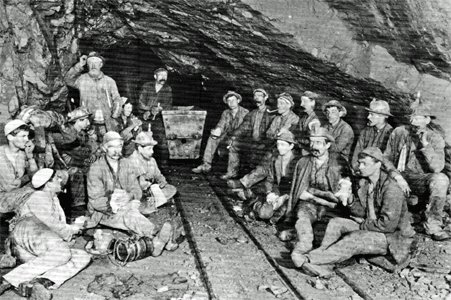 |
| East Pool Mine, Illogan "Croust (lunch) time", 1893 |
fares for themselves and their families. Their collective vote of no confidence in the future of their industry was dramatically demonstrated by the successive waves of emigrants who left their Cornish shores during the brief periods of return to any semblance of prosperity in the industry.
The underlying cause of these waves of emigration which drained Cornwall in the middle decades of the 19th. century is rooted in the declining prosperity of Cornwall’s former life-blood; the metal-mining industry. The collapse began in copper mining where, from its peak of production in 1855 after half a century of unprecedented boom, several factors combined to undermine the spectacular growth in production and usher in a massive slump. Foreign competition from newer and richer mines in Chile, Michigan. U.S.A., and South Australia, exacerbated the effects of outdated mining practices in Cornwall, a deterioration in the quality of ore, and rising production costs. Hard on the heels of the copper slump came a recession in tin which had lost an important market for tinplate in America with the onset of the American Civil War, whilst the phenomenal production of this metal in Australia also sounded a warning note for Cornwall.
Taken together, the two slumps in mining had a dramatic consequences for Cornwall; by 1865 the country was suffering in the depths of a disastrous mining depression from which it has never truly recovered.
There thus began an exodus from Cornwall the like of which had not been seen since the great Potato Famine emigration from Ireland to America. For many years previouly there had been a determined trickle of migrants to the New World, of perhaps the bravest and the best, to open up the mining fields abroad and to import vital skills to the fledgling nations; now the trickle became a flood as a kind of panic gripped the mining population of Cornwall; as the depression deepened it became increasingly common for whole families to depart - not always together. Emigrant “specials” were laid on on the newly established Cornwall Railway for passengers for embarkation ports for California, Queensland, Canada, Ballarat, the Brazils, Chile, and Mexico. For the means to move this flood of humanity was already in place; the construction of the great main-line railway system running virtually the length of Cornwall was finally completed on 6th. May 1859, when Prince Albert, consort of Queen Victoria, opened the Tamar Bridge, built by Isambard Kingdom Brunel to link Cornwall to Devon, and hence to the rest of England. The same year saw the first train run from Plymouth through to Truro; which traffic for the next fifty years would both sharply curtail sea traffic from Cornish ports and completely eclipse the glory-days of the county’s coaching system. From that period until the advent of the motorcar, train monopolized the transport system of Cornwall, carrying the tin, the fish, the china clay, the flowers and the vegetables of the county as well as its travelers. So when the mining slump first hit the Cornish economy, the rising tide rode out of Cornwall on the train.
Not only miners were enticed out of the county by the promise of a new life abroad. The closure of scores of mines threw many in ancillary industries out of work too; masons, carpenters, foundrymen, railway workers, coal- heavers, ore carriers, and rope makers were all among the outgoing tide from Cornwall. The handbills and newspaper reports of the time lend graphic illustration to this flight of tens of thousands, and the temptations of assisted passages to exotic lifestyles must have proved almost irresistible, not only to those suffering the worst effects of the depression but also to those on the fringes and no doubt influenced by the loss of brothers, cousins, uncles, and their families to foreign fields.
The first such account gleaned from the pages of the West Briton of 23rd. October 1863, headed “Emigration from Cornwall”, begins;
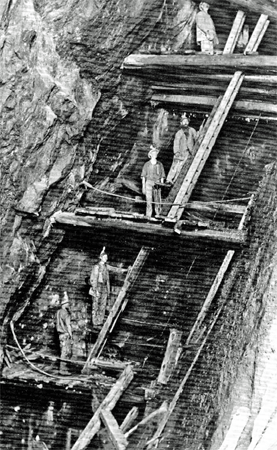 |
| Dolcoath Mine, Camborne, c. 1892 |
“Large numbers of the mining population are emigrating to Australia, Chile, California, New Zealand, Queensland and the United States... This migration from St. Just-in-Penwith, Camborne, St. Agnes, and St. Blazey districts is becoming a matter of grave consideration; and mine agents and others are beginning to feel the scarcity of labouring hands...”
On 18th March 1864 was recorded “Emigration From The Delabole District”;
“There is a great emigration going on amongst the labouring classes from the neighborhood of the Delabole Slate Works. A Cornishman, who has been in the United States, and worked there very successfully, having returned home with his wondrous stories, has so wrought upon the minds of the people that a large number of them are thinking of emigrating, and about twenty families are now on their way to Liverpool for that purpose.”
The statistics begin to speak for themselves. It was reported in the West Briton of 17th May 1867 that,
“During the last twelve months, Cornish miners to the number of 7,380 have left the county, 1,155 of whom have settled in America, 670 in Australia and New Zealand, 450 in California, while the iron mines of Scotland and the coal mines of the North of England have absorbed 1,090...”
Meanwhile, life in a typical Cornish town, such as Penryn, near Falmouth, was described as slumbering in a state of desperate neglect; a report dated 31st March 1870 from Board of Health stated;
“The roadways are in a state of great neglect; stagnant pools, decomposing vegetables, and other filth lie about, and until the commencement of the present year it had been the prevailing custom to render the condition of the town even more disgusting by emptying the contents of privies, middens, and cesspools into the streets, leaving them there until removed by carts.”
Small wonder then that against this background of poverty and uncertainty, the Trevethan family heeded the call to foreign parts which put Thomas en route for New Zealand in 1870.
No doubt the tales told by the returning miners “back from the diggings”, with their ostentatious displays of new-found wealth, strutting about in cowboy hats, sporting rings and other jewellery, and dispensing their hospitality far and wide, attracted much notice and spurred on those with less stomach for adventure. The lives of those who stayed behind continued to be punctuated by the dreaded visitations of cholera, typhus, and smallpox; and mining, quarrying, and shipping disasters were all too frequent. One such at Delabole slate quarry was reported on 29th April 1869, and must have found ready sympathy from Thomas Trevethan, slate Quarrier, perhaps already contemplating emigration;
“The accident happened when the largest poppet head - a huge staging with pulleys for drawing slate to the surface - collapsed, together with the cliff on the edge of which it stood, and fell 300 feet into the quarry below... most of the men on the poopet head had been buried... The fall of so huge a mass, which would considerably exceed a hundred thousand tons, caused a tremendous crash, which was followed by a rush upwards of a violent blast of wind and stones. Fifteen workers were killed and six seriously injured.”
Four years after the disaster, one of the victims, a woman, was discovered beneath eight feet of fallen slate. She was still holding the tea can and food basket she was taking to her father at the time.
Thomas Trevethan is described as a slate quarrier at the time of his emigration to New Zealand in 1870. He had married Jane Ball in 1869 whilst living at Tregunna with his parents. The nearest slate quarry would have been Tregunna Camel Quarry, just half a mile west of Tregunna. In 1682/3 over two million slates were exported from Padstow, including many from the Camel Quarry. There were many quarries dotted around the neighborhood, including that at Tredinnick, where Thomas’s uncle, another Thomas, was farming at the time of the 1861 Census.
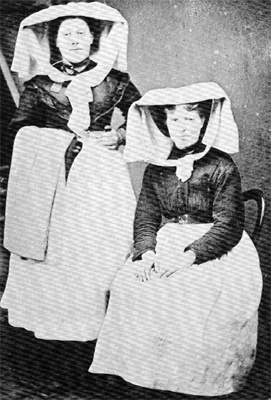 |
| Bal Maidens from Dolcoath Mine |
According to Frank and Doris Wilce at Tregunna, barges came down the Cammel River from Wadebridge and moored near the Camel Quarry to take the slate. This method of freighting the slate would have been found easier than carting it out by road, and also enabled delivery of far larger slabs than would have been possible by road. The Royal Cornwall Gazette reported on January 11th. 1856;
“Camel Quarry Near Wadebridge - The usual quarterly account was held at the Quarry, on Thursday, the 3rd instant, when the expenditure for the last three months was duly audited and assessed, and the balance of 230 odd carried forward to the credit of the Company, and which with the amount due on the sale of slate was more than sufficient to pay all its outstanding liabilities. It was determined however to prosecute the works with vigour, and a call of 25 per 32nd share was made for that purpose. The committee reported that the stone in the bottom of the Quarry had considerably improved during the last three months, and that they had proved the existence of slate for a further depth of 36 feet, and it was still improving in quality. The Company were pleased to find on the works an immense quantity of excellent flooring, many stones of which reached from 60 to 80 feet in a single stone, also several thousand dozen of good second quality rags and scantle. The machinery worked well and there was abundance of stone to keep the same fully employed. From the above it will be seen that the company have now reached the point (after a long perseverance) of being able to supply the required wants of the public.”
Vol. I of Lake’s Parochial History of the County of Cornwall, 1867, records that the nearby Penquean Quarry was working, and had been for some years;
“Articles in slate are manufactured to a considerable degree of perfection, especially chimney pieces, water tanks, and drains. Flooring is also prepared, as well as roofing slates &c.”
By 1881, the 1st. edition of the Ordnance Survey 1:2500 series (25":1 mile) marks both quarries as disused; some time between 1867 and 1881 the general slump in mining and agriculture must have hit slate too. Strange to think that the London and South Western Railway would reach Padstow from Wadebridge in 1899, but too late to rescue the dwindling fortunes of slate. The proximity of the railway line to the slate quarries would have made it much easier to reach a wider market up-country when the home market in Cornwall faltered, but it was never to be.
The downturn in the mining industry already described, and the subsequent closure of scores of mines, doubtless had the knock-on effect of a downturn in new building; miners thrown out of work and leaving the county in droves would not have been building themselves new houses as they did during the boom periods of the industry, and the mining companies would have had no need to erect rows of cottages for their workers. Indeed many houses and cottages must have been abandoned at this time, and in many of the mining areas scenes of dereliction were frequent, with grass growing in streets which had become almost disused. The demand for slate would thus have dived with the crashing fortunes of the mines. Thomas Trevethan more than likely found himself laid off or on short time; little wonder then that he decided to emigrate and make his passage to New Zealand maybe via Australia to carve out a new life. The poverty at home must have been almost soul-destroying.
Thomas Trevethan obviously intended his family to follow him to New Zealand. The birth of his daughter at St. Breock on 19th. October 1870 suggests that he and his wife quite sensibly preferred not to risk childbirth at sea, and so he left his wife behind, no doubt intending her to follow later with their new child. Something seems to have gone wrong with this plan; perhaps Jane died in or shortly after childbirth, though where she is buried is not known. It would be another twenty-two years before daughter Elizabeth Jane would make the passage to New Zealand, having been bought up in her mother’s absence by her paternal Grandparents, David and Elizabeth, at Tregunna. David lived at Trevance when he married in 1847, and was described as a miner. The nearest mine working would have been at Carthew, about a mile east of Trevance; today all that remains of this working are some disused mine shafts and tips. A farm nearby bears the same name.
The life of the Cornish miner was often cruel and always hard. He received not wages but “tribute”, which was a system allowing him so many shillings out of every pound’s worth of ore he sent to the surface. This depended therefore on the richness or otherwise of the vein or “lode” on which he worked. A rich lode might give £20 or £30 for a month’s labour, a poor one send him home with nothing at all. His average income was around £3 a month, on which he had to support his family. No doubt he would try to supplement this with other work, labouring on the farms, where he could and where time allowed. Often one job in the mine was shared by all the male members of the family; they would take it in turns to go on shift, and the women helped, too, sorting rock and breaking it up with hammers, “dressing” the ore to make it ready for smelting to extract the copper or tin. These women were called “Bal-maidens”.
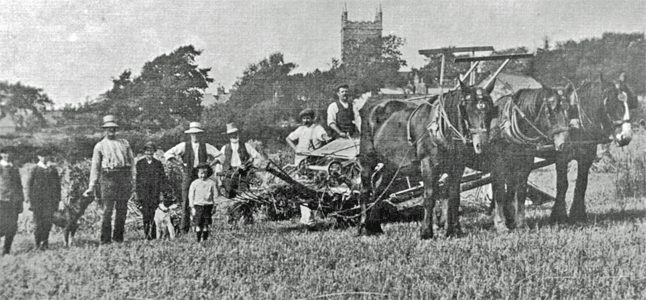 |
| Near St Issey 1913 |
Life underground was unhealthy and dangerous. The temperature could reach 115 degrees Fahrenheit in the deep levels, and water would scald any unlucky enough to fall into it. The men worked almost naked, clad only in loose trousers, and sweat streamed down their faces and bodies. The beginning and end of an eight-hour shift often meant a climb of up to a thousand or fifteen hundred feet of ladders; the walk to and from the mine, often undertaken in darkness also, might be a six miles or more. At certain times of the year, perhaps the whole of a miner’s life was spent in darkness. The contrast in temperature between the underground levels and night frost at surface must have been an unwelcome burden on top of the back-breaking labour at the rockface. The scenes at the beginning and end of shifts would have been of whole communities, rising almost as one, converging on the mines or returning to their scattered cottages like swarming bees, full of clatter and chatter. Once having reached the mine, each would disappear to his or her own allotted task; women and children to the rough dressing sheds, barely providing shelter from all weathers, the men stripped off to make their underground trek. A remarkable silence was said to descend once the shift started - scarcely anyone could be seen, and the tall engine house chimneys of the steam engines emitted no smoke; the only observable motion being that of the rhythmic “bobs” or levers of these gigantic pumping machines.
The agricultural economy, the second of Cornwall’s three primary industries (farming, fishing and mining), was also about to suffer a period of long decline following repeal of the Corn Laws in 1846; the effects would not really be felt until 1874/5 onwards when the dismantling of her trade barriers by the Repeal Act made England vulnerable to America’s surplus wheat, once cheap rail and ocean transport opened up the way for the virgin prairies of the Middle West to flood Britain’s market with cheap American wheat. The immediate effect on Cornwall was to impose a decline in arable acreage of 59% between 1875 and 1893 and a corresponding increase in the area put to grass, by 70%. The traditional emphasis of Cornish farming now switched from very labour intensive grain growing (which had always paid the rent) to the far less labour intensive fodder crops and livestock. The effect on the labour market was to accelerate the exodus from the rural areas. St. Issey had long been considered one of the best grain-growing parishes in Cornwall, so the effects must have been particularly severe on the lives of the Trevethans, whose occupations had always turned on the prosperity of the traditional Cornish economy.
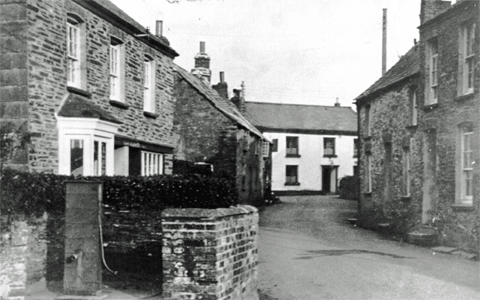 |
| St Issey Village 1908 looking towards Ring o'Bells pub. |
Other social changes were also afoot; following Government inquiries into conditions of employment of children, young persons, and women in agriculture, in 1867, a system of compulsory education for young people was brought in by an Act of parliament in 1870. Farmers had already made their opposition to such a system known, fearing that by this means the younger generation of labourers would come “to put themselves above their masters”, and that they would suffer an increase in rates to pay for it. In spite of their opposition the Act came onto the Statute Book, and its effects would be dramatic and far-reaching as a mechanism for social change. St. Issey National School was in fact set up in 1868, anticipating the Act by two years. It is and always has been associated with the church; parents originally paid one penny per week to have their infants cared for. The Log Book of the school’s early years makes interesting reading, with frequent references to absences amoung the children due to their helping out with farming chores, thus; absences in March for planting potatoes and picking stones; in April for tilling grain and potatoes; for weeding and stone picking in May; harvest in July; and picking potatoes in October/November. Traditional high days and holy days were also taken, such as Padstow ‘Obby ‘Oss (May 1st.), and the summer break called harvest holiday. Even the assistant teachers were not averse to absconding to undertake other necessary work in the village, such as sewing.
Various Trevethans are recorded on their passage through school. Thus at page 73 of the Log, dated week ending January 19th. 1872;
“Admitted Evan Trevethan on Monday morning and placed him in the second class.”
Week of January 25th. to January 30th. 1875;
“Admitted L. Trevethan this (Monday) morning”.
and, during the week April 20th. to 25th. of the same year;
“Caned William Lean for making L. Trevethan’s nose bleed.
Burgois Tea Treat was seemingly always a good excuse for a holiday; thus we find recorded on July 26th. 1878;
“Half holiday on Monday, as several children attended a Sunday School Tea, at Burgois.”
Other interesting entries in the School’s punishment book for the same period are;
“L Trevethan - talking”
“Les Trevethan - talking”
“Les Trevethan - constant turning around”
“Les Trevethan - insolence”
“Les Trevethan - grinning”
“Harry Trevethan - persistent talking”
“Harry Trevethan - upset ink, splattered on wall”
“Len Trevethan - playing and talking”
“Harry Trevethan - throwing stones”
“Len Trevethan - disobedience”
“L Trevethan - disobedience”
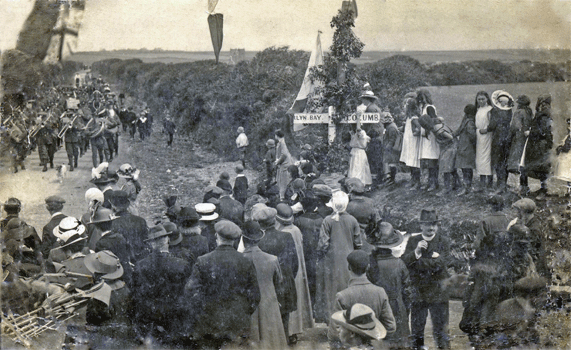 |
Soldiers at St Merryn Cross Road - from Malc McCarthy's collection
|
1572 Stephen Trevethan 1579 Robert Trevithven St. Ervan 1588 Enego Trevethan Padstow 1610 Pascowe Trevithan St. Evall 1644 Thomas Trevethan St. Ivall 1655 John Trevithvan St. Merryn 1662 Christoper Trevithan St. Ivall 1668 Gertrude Trevethan St. Evall 1669 Richard Trevethan St. Merin 1697 Stephen Trevethvan Padstow 1701 Catharine Trevethan St. Meryn 1703 Thomas Trevethan St Meryn 1711 Thomas Trevethan Padstow 1713 John Trevethan St. Meryn 1713 Stephen Trevethan Padstow 1725 Mary Trevithvan Padstow 1732 William Trevethan St, Meryn 1732 Samuel Trevithnan Padstow 1740 Jane Trevethuan Padstow 1740 Robert Trevethuan Padstow 1773 Grace Trevethan Padstow 1793 Joseph Trevethan PadstowThe school frequently changed its headteacher; on September 30th. 1878 R. W. Tonkin took charge, from Michaelmas (29th. September) to Christmas only. Recorded on October 4th. we find his observations;
“Found the children in very bad order. They seemed to be accustomed to running into the school, doing just as they pleased. I have had a deal of trouble to keep them in order. They are also very idle and backward in their work. Arithmetic is especially weak, the children requiring a (sic) plenty of practice in the simple rules. Geography and Grammar although taught, are very backward...”
On December 30th. 1878 a new headteacher took over;
“I, John Charles Taylor have today commenced duties as master of this school. Found the children very disorderly and spoke to the Vicar, the Rev. Mann as to the best means of general improvement.”
On March 15th. 1880 we find
“Admitted Chas. Trevethan”,
and on November 8th. of the same year,
“Readmitted Zach. Trevethan”.
By 1880 attendance at school was made compulsory for every child. The school’s attendance register for 1880 includes the following;
Zachariah Trevethan
Samuel Trevethan
Mary Edith Trevethan
Mary E. Trevethan
William Trevethan
Annie Trevethan
Elsie Trevethan
Leslie Trevethan
Kathleen Trevethan
Gertrude Trevethan
Harry Trevethan
Gertrude Trevethan
Leonard Trevethan
An interesting first-hand account of what life was like in 1867 for a child who, like many attending St. Issey School, was an irregular attender, for the same reasons, is recorded by the commissioners appointed to inquire into conditions of persons employed in agriculture in that year (referred to earlier), thus;
“Ellen Pierce (eleven years old), described by the schoolmaster of the same village (Gulval, near Penzance) as being very irregular in her attendance, stated in explanation:
‘I have been at pulling radishes at 7d. a day, the hours of work being from 8 a.m. to 6 p.m. I go home to dinner from 12 to 1 o,clock. Men, women, boys and girls all work together when it comes to potatoing. We were seven girls, five boys, and three women, with one man to fill in the drills. The older girls go away early from the morning school to cook or carry dinner for their mothers in the gardens. My aunt works in the garden and gets 5s. or 6s. a week. In my cottage we have one kitchen, one bedroom, and a dairy. Mother, aunt, grandmother, and myself live there together.’”
Thomas Oliver, also of Gulval, and aged seven years, told the Commissioners;
“I have been out putting down potatoes and got 4d. a day, working from 6 a.m. to 6 p.m., half an hour being allowed for dinner.”
John Carter, of Ruan Minor, aged ten years, described his life too;
“I was out at work last year and this driving horses for a farmer, and putting in potatoes. I got 1d. a day and three meals; milk for breakfast, meat and no drink for dinner, bread and milk for supper.”
Apparently the majority of children started work at ten or eleven years of age (prior to compulsory schooling in 1870) and received, at the most, just 6d. a day.
An account of farm life around 1850 (Cornwall and its People, by A. K. Hamilton Jenkin, page 332) illustrates how whole families shared in the work in the fields;
“...the normal hours being from 6 a.m. to 7 p.m. By 8 o’clock the women and children of the house hold had likewise found their way to the fields, where they were employed till six in the evening weeding grain, hoeing turnips, picking stones, planting potatoes, rolling barley and oats, hay-making or reaping with the sickle.”
The babies were left at home to fend for themselves, with at best, an older child to care for them. Children crying from cold in winter weather in the fields were not an uncommon sight; they would be engaged in pulling frozen turnips with hands so blue and numb they were scarcely able to grasp. Men, women and children would return to their homes after a long day’s toil, worn out with fatigue, only to have to start on their household chores of cooking, baking, sewing, or fetching water, before they could take their rest.
Commissioners’ inquiry showed that there was considerable variation at this period between the cottages of the agricultural labourers in different parts of Cornwall. However, almost without exception, they are all described as being over-crowded. The Looe relieving officer reports;
“I was lately in a labourer’s cottage in the parish of St. Martin, where the family consisted of nine persons with only one room...”
The rent for a cottage in the Liskeard district was said to vary from 50 shillings to 5 pounds, 5 shillings a year, but near Penzance, where the land was particularly fertile, property was more expensive, and rents ranged from 4 to 6 pounds a year. (In 1867 the average adult wage in mid-Cornwall was 8s. a week.) Privies were rare, and water supplies a non-existent luxury; indeed St. Day, near Redruth, was not connected to the mains water supply until 1947! By some seemingly bizarre compensation for this it was found that in some instances the (earthen) floors of the downstairs rooms were “as damp as the roads outside”. (Hamilton Jenkins, op. cit., pp. 343-4)
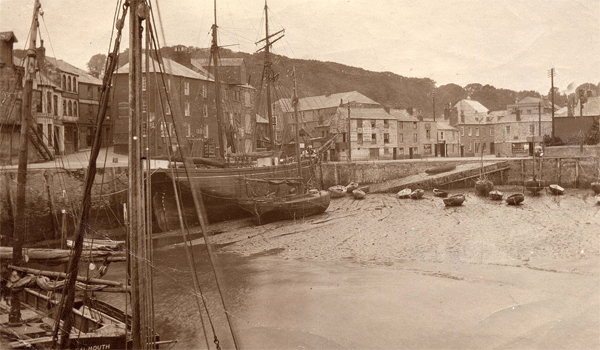 |
| Padstow Quay - from Malc McCarthy's collection |
An interesting description of life at home for the Cornish in the 19th. century can be found at page 24 et seq. of the booklet “Victorian Cornwall” by S. Daniell;
“... most of the Cornish poor a hundred years ago subsisted principally on pilchards, potatoes, vegetable broths, pasties and similar foods - a diet that was filling rather than sustaining. Those near the coast, like the Trevethans from St. Issey, were familiar with other seafoods, mullet, conger and gurnet for instance, or even limpets in hard times but the pilchard was the fish most readily available to “the country”, who salted thousands down for winter consumption in a variety of soups and pies. No doubt some found their way into Cornish pasty of barley flour which, although customarily made of “turmut, tates and mate”, could be provided with almost any kind of sweet or savory filling ...”
So this is where we left our paid research in Cornwall as it seemed to me, after visiting the area for myself, that the story of our early family is as complete as it is ever likely to be.
So the next step was to write a letter to all the people by the name of Trevethan in the English telephone books. Although we sent off a large number of letters we received only two replies. One was from a Mr Joseph Trevethan who had an old Family Bible and came from the Padstow area. However, at the time, I was unable to connect the family, but some years later found the connection. He can be found on page 218. The other was really very exciting as it came from a young couple, John and Beatrice Trevethan who after a lot of research on their behalf managed to link their present family with our New Zealand family. The information they provide and their own family tree is shown on page 152. Unfortunately this couple are now separated and I have lost contact with them.
I then wrote to County Archivist at the County Record Office in Truro, Cornwall and asked for copies of all the wills they held for the name of Trevethan. There were fifteen wills and bonds for the eighteenth century but none from the St. Issey area. There were also eight wills and bonds for the seventeenth century, but again none for St. Issey. For the nineteenth century there were ten wills and bonds. There were two for Padstow which is only three miles from St. Merryn though St. Merryn itself came under the direct jurisdiction of the bishop of Exeter and wills from there were proved in the consistory court of the bishops of Exeter. Unfortunately the wills of all these so-called peculiar jurisdictions were destroyed when the Probate Registry at Exeter was destroyed by bombing during the last war. What makes this almost unbearable is that a list of the wills that were in Exeter before the war lists fifteen that belong to our direct line including one for Stephen Trevethan who died in 1572. These wills would have told us a lot about the wealth of the family around that time and about the personal items they owned. However the remaining wills are now providing a wealth of information on the other lines of the Trevethan family including the will of the first Trevethan to go to America, but more about that in another section of this book.
The Wills Lost In The Bombing
1572 Stephen Trevethan
|
1579 Robert Trevithven St. Ervan
|
1588 Enego Trevethan Padstow
|
1610 Pascowe Trevithan St. Evall
|
1644 Thomas Trevethan St. Ivall
|
1655 John Trevithvan St. Merryn
|
1662 Christoper Trevithan St. Ivall
|
1668 Gertrude Trevethan St. Evall
|
1669 Richard Trevethan St. Merin
|
1697 Stephen Trevethvan Padstow
|
1701 Catharine Trevethan St. Meryn
|
1703 Thomas Trevethan St Meryn
|
1711 Thomas Trevethan Padstow
|
1713 John Trevethan St. Meryn
|
1713 Stephen Trevethan Padstow
|
1725 Mary Trevithvan Padstow
|
1732 William Trevethan St, Meryn
|
1732 Samuel Trevithnan Padstow
|
1740 Jane Trevethuan Padstow
|
1740 Robert Trevethuan Padstow
|
1773 Grace Trevethan Padstow
|
1793 Joseph Trevethan Padstow
|
Two Visits to Cornwall
July 1990
In July of 1990 I was lucky enough to fill a longtime desire to travel to England and thus down to the north west of Cornwall where our forbears emigrated from to New Zealand starting in 1870. As one drives from London on the six lane motorways you cannot imagine what awaits you when you reach Cornwall and the motorways make way for smaller and smaller roads until you are driving on very narrow country lanes, with high rock walls on both sides and with just room for one car. Although much of Cornwall has been spoiled with modernization and domestic tourism the area around the small town of St. Issey nestled between Padstow to the west and Wadebridge to the east has remained unspoiled and not too different from the way it was a century ago.
The town of Wadebridge stands at the head of the estuary of the River Camel, giving attractive river scenery together with some splendid woodland walks. It takes its name from the Roman “vadum” - a ford. The bridge in the centre of the town is over 500 years old and still in daily use. In the past Wadebridge was a port by which merchants traded with Ireland and the Mediterranean.
The town of St. Issey itself would have only a small population as it consists of only a couple of very narrow streets and at places two cars can not pass each other. In the center is the parish church and church school surrounded by a good number of old stone buildings with slate roofs. There are a couple of very small shops, two garages, a Post Office agency and of course a real English Pub dating back at least three hundred years. As one sits in the Pub and samples a pint of real Cornish beer and eats a Cornish pastie you can almost feel the long history of St. Issey and in particular the Ring- o-Bells Pub.
The old stone church has a long history and no lesser authority then C G Henderson wrote in 1921; “it would be quite impossible to ascertain the date of the consecration of the first church at St. Issey. This took place in Celtic times, probably in the 7th or 8th century, and no records exist for this early period. The advowson belonged, like the whole deanery of Pydar, to the bishop and monks of St. Bodmin. It was taken from them when the Bishop’s Stool was removed to Devonshire in the 11th century and given to the new see. About 1190 the bishop off Exeter gave the patronage and great tithes to the Dean and Chapter of Exeter cathedral. The old name of the parish was Eglos-cruck, which means “the church on the (sepulchral) tumulus”, or “the church on the mound”. William Lumbard was the last rector, C.1190. The list of vicars dates from 1266 when Walter le Prior was appointed”.
July 1994
1993 saw us once again in England but this time for a much longer stay of six weeks having just completed the longest railway journey in the world from Hong Kong to London and before going to America and a journey across the States by mini van.
There was only time for one week in Cornwall and this time we managed to see much of the rest of Cornwall that we had missed back in 1990 although the weather was far from perfect with rain every day. Still Cornwall is a charming place and we enjoyed poking around the small lanes, visiting churches and small fishing villages.
We managed to meet up with Stephen Trevathan an American cousin who now lives in London and Barry Trevethan a distant Cornish cousin from Devon. Time is never enough as it seems unlikely that we will ever have the opportunity again to visit Cornwall but one is left hoping.
In our hire car we drove down to St Martins near Penzance on the south coast of Cornwall along mostly good roads and camped at the Seafarers Camping Ground. The next day we left for Padstow in light rain. On the way we visited Perranzabuloe Church where one line of the Trevethans had lived but found nothing of interest. Then on to Trevone down a very small winding lane. Next on to St. Issey to see a Trevethan relation and then to Padstow to visit yet another. Past St. Merryn church on the way back to the camp and saw that our family crest is still on the wall. Still very wet with thick drizzle.
On the third day there was more thick drizzly rain with mist down really low. We headed for St. Just to look for the Cornish tin mines. Turned out to be a waste of time as we couldn’t find the place due to the very thick fog so returned to the camping ground for lunch to wait for Stephen Trevethan to arrive from London. Stephen may be a very distant relation but I do not know the connection.
On returning to the camping ground we found Stephen was already there. Good to meet him and after talking for ages we head to Mousehole to find a place to eat as it was still far too wet to cook outside. Mousehole is a wonderful small village by the sea. Quaint small cottages and very narrow lanes. Found a lovely small restaurant and we had a homely meal of Cornish Paste and salad with homemade apple pie and clotted cream for desert. Clotted cream is a Cornish specialty and is very nice.
We then went down to Lamorna Bay. What a lovely spot and one could almost feel the history and see the smugglers coming ashore. Couldn’t take any photos as it was very grey and getting dark.
The next day it was still wet outside having rained very hard all night long. Sky was clear so we decided to go to St. Just again in search of the Cornish tin mines. This time we found them easily and they were superb. Great sight of the tall chimneys towering into the sky on the top of the cliffs over looking the sea. It was still grey and threatening to rain yet again.
In the afternoon we set off with Stephen to Truro and the museum. Interesting but we did not have the spare time needed to look at all the references they had to the Trevethan family.
The next morning it was farewell to Cornwall as we crossed the River Tamar to continue the rest of our tour of Great Britain.
Click the links below to view family trees.
 |
 |
 |
 |
 |
 |
| Tree 2 |
Tree 3 |
Tree 4 |
Tree 5 |
Tree 22 |
Tree 23 |
 |
 |
 |
 |
 |
 |
| Tree 70 |
Tree 73 |
Tree 85 |
Tree 86 |
Tree 88 |
Tree 89 |
 |
 |
 |
 |
 |
 |
| Tree 90 |
Tree 91 |
Tree 93 |
Tree 94 |
Tree 104 |
Tree 105 |
 |
 |
 |
|
|
|
| Tree 106 |
Tree 110 |
Tree 114 |
|
|
|

|
